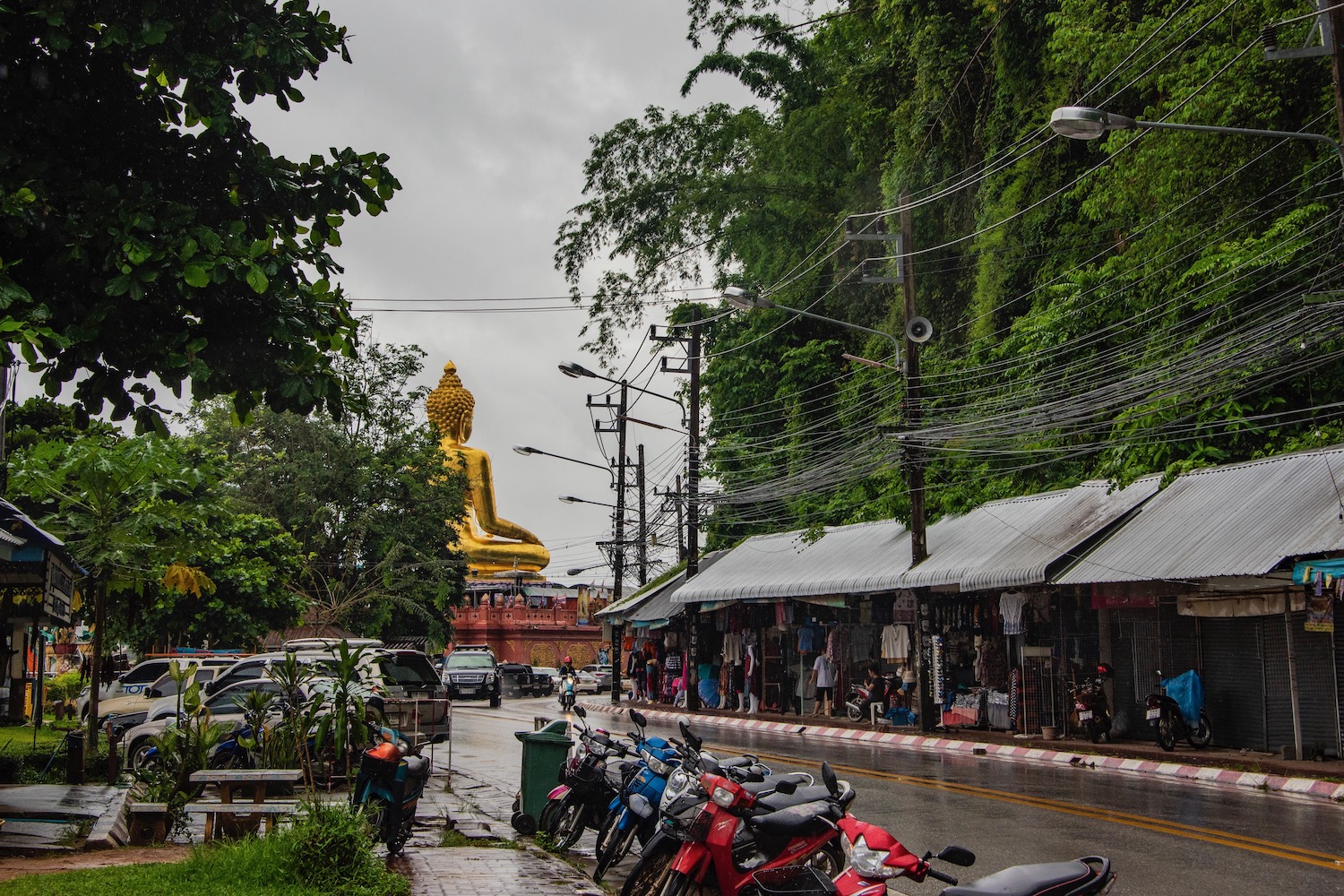One of my most vivid Thailand travel memories happened in July 2017—the wettest part of Thailand’s rainy season that yet. I was landing in Chiang Rai, and although I had an aisle seat, I remember being literally drawn to the window as if by possession.
Just beneath the plane, the rice fields extending for miles around were so verdant they almost appeared they couldn’t be real. The paddies were as full with water as they were lush with greenness; I kick myself often for having put my camera bag in the overhead bin.
I’ll outline other reasons you might want to visit Thailand in the rainy season, but the general point I’m trying to make will carry throughout this article: It definitely isn’t some terrible time you should avoid!
What Living in Thailand Taught Me About Local Weather
Before I moved to Bangkok, I was adamant about avoiding Thailand in the rainy season. Friends of mine who’d made trips there during rainy months seemed to have regretted doing so, and in the pre-social media era, that was really the only metric I could use. The first time I lived in Bangkok, however, it just so happened to that my sister could only come in September, i.e. one of the rainiest months.
While the pictures weren’t amazing, the experience was unique, especially in the islands—we had many beaches all to ourselves! Beyond this, living in Thailand and realizing that many days in “rainy” months were perfectly sunny forced me to accept that Thai weather isn’t neatly demarcated into wet/dry. There are shades of grey. Or rather blue, since it’s completely possible to enjoy beautiful, blue skies during the annual monsoon.
5 Reasons to Visit Thailand in the Rainy Season
The air is cleaner
You’ve probably heard a lot in the news recently about how terrible Thailand’s air quality is. While there are no easy long-term fixes to this problem, nature does have a foolproof one: The rainy season! Whether in the North, South or Bangkok, Thailand’s air is virtually always clean and fresh during the rainy months.
Temperatures are cooler
Another advantage of visiting Thailand in the rainy season? Frequent rains tend to cool things down, although “tend to” is the operative phrase. In some cases, if the sun comes out strongly after a rainstorm, the immediate heat and humidity can be overwhelming—plan this one by ear.
It’s less crowded
Because Thailand’s wetter months have a generally terrible reputation, the majority of foreign tourists avoid coming at this time of year—this is also true for Thais. So whether you’re visiting major destinations or going off Thailand’s beaten path, you’ll have more of the places you visit to yourself.
(And also less expensive)
Not surprisingly, light crowds in Thailand in the rainy season mean that prices tend to be lower. Which is not as significant a fact as it would be in other places—Thailand isn’t known for being an expensive country—though it is especially welcome due to price increases across the board since the end of the pandemic.
Imperfection allows for revelation
Are you going to get a postcard-perfect beach shot with blue skies and calm waters if you visit Thailand in August? Almost certainly not. But whether you go to the islands and have a unique and unforgettable experience, or enjoy the charms of the underrated “green season” up north, this imperfect time of year may just yield your perfect trip.

Where Should You Avoid During the Rainy Season?
Earlier in this piece, I mentioned visiting some islands (specifically Koh Mook and Koh Kradan in Trang) with my sister many years ago. While we had a great time in the end, the rain was definitely heavier and more of an all-day thing here—my pictures from the trip weren’t great. Moreover, the long-tail boat ride from the pier (and back to it) was probably more dangerous than I’d be willing to repeat, if given another chance.
Does this mean you should avoid the islands (and, more broadly, the South) if you travel to Thailand in the rainy season? Not necessarily. However, I would say that the negative aspects of this time of year are more pronounced in places where you expect to see sun. It’s less essential to having a good time in Bangkok (which has plenty of indoor spaces) and in the north, where the lush greenery I mentioned earlier really does enhance the experience.

Other FAQ About Thailand Rainy Season Travel
What is the rainiest month in Thailand?
Thailand’s rainy season generally takes place anywhere from mid-May to late-November, though this varies based on the time of year and where in the Kingdom you’re traveling. In most years, you can expect July, August and September to be the rainiest months in Thailand.
Is it worth going to Thailand in rainy season?
It is absolutely worth visiting certain parts of Thailand during the rainy reason, though this isn’t always the case. I especially love spending time in the North, which becomes extremely lush and green when rains are falling. Another benefit of rainy season travel? The air becomes completely clean of pollution.
What to do in Thailand in the wet season?
If you’re traveling in northern Thailand during the wet season, you’ll definitely want to tour rice paddies and other natural areas, which are delightfully verdant and fresh. In Bangkok, depending on the weather, you might want to prioritize indoor experience like shopping and movies. In the islands, it’s really more of a dice roll, which is why I sometimes recommend against visiting southern Thailand during rainy months.
The Bottom Line
You’re not crazy for considering a trip to Thailand in the rainy season. And not just because it’s relatively common to have hours or even full days of sunshine and blue skies during the “wet” months. Among other reasons, the regular rain of the summer monsoon washes out Thailand’s increasingly pervasive pollution, all but guaranteeing you fresh, clean air during your trip. Moreover, many parts of the country (especially the north) are delightfully lush and green, which can help to counteract even the greyest skies. Need personalized help planning a Thailand trip at any time of year? Consider hiring me to help!






